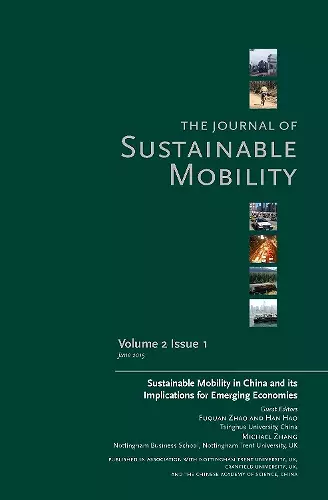Journal of Sustainable Mobility Vol. 2 Issue 1
Sustainable Mobility in China and its Implications for Emerging Economies
Fuquan Zhao editor Michael Zhang editor Han Hao editor
Format:Paperback
Publisher:Taylor & Francis Ltd
Published:31st May '15
Currently unavailable, and unfortunately no date known when it will be back

After three decades of rapid economic growth, China became the world’s second largest economy in 2010 after the United States of America. Along with the prospect of lifting millions out of poverty and improving living standards, China is facing yet new challenges of rapid urbanization. Recent research findings show that in 2012 urbanization rate was 52.6% in China (Lacy et al., 2013). It is predicted that by 2020 the number of megacities in China with an urban population of more than 10 million will increase to thirteen. Along with the increase in urban population and living standards there has been rapid increase of car ownership in China. It is estimated that there are more than five million vehicles in Beijing (Cheng, 2013; Economist, 2013). Large cities and prefecture-level cities already contributed 89.6% of China’s total industrial CO2 emissions. One day in January 2013 air in Beijing was heavily polluted to a level of toxicity (smog) forty times the standard safe level set by the World Health Organization (Economist, 2013).At the international level, transport contributed 61.5% to world petroleum consumption and 22.3% to global CO2 emissions in 2010 (IEA, 2012). While the overall level of CO2 emissions in developed economies is stabilizing and in some cases declining, the levels in the developing and emerging economies are increasing. Large emerging economies with megacities will imminently become the major concerns of transport-related CO2 emissions. Without strategic innovations in the automotive industry and transport management system the current state of China’s transport sector is not sustainable. The long-term sustainable solutions are likely to emerge from the interplay of economic, environmental, social and technological factors.The Special Issue, partnered with the Second International Symposium on Sustainable Mobility, focuses on the issues of developing policies and corporate strategies to help the automotive industry, transport management systems, and urban planning to embark on a sustainable path to future growth and development (WBCSD, 2007; World Bank, 2008). The critical debate and research findings of this issue shed light on future research and practice on sustainable mobility in emerging economies.
ISBN: 9781783535200
Dimensions: unknown
Weight: 160g
74 pages